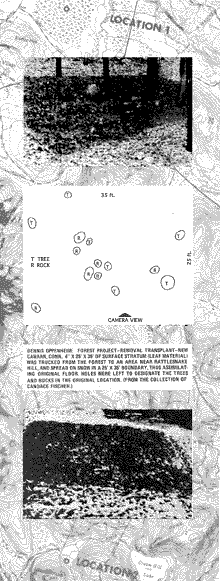|
|

Dennis Oppenheim: Forest Project — Removal Transplant — New Canaan, Conn. 4" X 25' x 35' of surface stratum (leaf material) was trucked from the forest to an area near Rattlesnake Hill, and spread on snow in a 25' by 35' boundary, thus assimilating original floor. Holes were left to designate the trees and rocks in the original location. (From the collection of Candace Fischer). 
|
|
NOTES ON ECOLOGIC PROJECTS BY DENNIS OPPENHEIM Much of my work deals with two distinct placements. The art gallery, on one hand; land mass on the other. Conceptually they share similar ingredients. In the gallery, my concern with decomposed matter is more directly related to place, and explores, problematically, the justification of object placement. Therefore, the material matter of my conic pile would be composed of material ingredients of the supports on which it rests. Example: a conic pile leaning into a vertical wall support, spreading to the ground, would be made of the same ingredients as those supports (gypsum, sand, concrete) thus allowing the compositionalized matter to become the place on which it rests. In other words, decomposed form is not put in a place — it is that place, devoid of manual organization, eradicated of all imposed rigidity, free to respond only to extension, inertia, and gravitation. · As for my land pieces: the negative particle slide in Long Island, which continues with expanding arcs for 1,000 feet, could conceptually (in a manner similar to radar bands) travel the extent of the globe. This factor of articulating land area in terms of prescribed distance markers led me to some interesting ideas, in that distance (footage, yardage, etc.) is tangible when applied to specific land surface, it must be regarded as sculpturally significant. Merely by driving two stakes at separate points, you are working with points, you are working with tangible sculptural form. Seeing distance as the time required to span an area is another consideration which draws further away from our traditional concern with objects. Shortly after the Long Island piece, in search for land parcels with particular surface characteristics, I ended up in Pennsylvania. It was July and the farmers were beginning to harvest wheat. My first field piece involved the use of commercial snowfencing — 4'x5O' — to create linear cuts in the surface media. Any imposed linear pattern seemed forced, so I worked mainly with long, single directional cuts. In some cases, however, the fencing was curved and grouped to assimilate truncated or incomplete contour lines. My contours were in opposition to the existing topography. After watching numerous wheat harvest operations, I approached a farmer in Hamburg, Pennsylvania, asking to direct or plot the harvester's course. My instruction was simply to make a cut directly down the center of a 200'x900' field bordered by corn which was alloted to me. The same farmer will allow me to organize the planting of his corps (corn, orats, barley, hay, wheat) this coming year. What became interesting with the field pieces were the isolated stages of progress. If we see the 200'x900' field of wheat as a kind of non—rigid media held in geometry, which through linear cuts or eradications are transformed in separate sub-forms (bales) later to be subjected to a mobile topographical displacement (trucking bales to stock piles,) each stage is art. · Another piece, located on a New Haven, Connecticut swamp grid is divided into rectangles (150'x 175'), each bordered by water. Using a sickle mower, I scribed altitude or contour lines in the thick surface. The cuts were filled with iron filings (residue from steel borings.) Altitude lines on contour maps served to translate mea surement of existing topography to a two-dimensional surface. With my piece, I create contours which oppose the reality of the existing land, and impose their measurements onto the actual site, thus creating a kind of conceptual mountainous structure on a swamp grid. · My use of contour lines taken from maps and enlarged has always stemmed from a rejection of a compositional order. I did not want merely to scribe a composed gesture on land, snow or whatever. To avoid this, I use information data from charts, etc. In some ways, this is close to Sol LeWitt. He too is trying to avoid compositional order by having a serial order dictate the eventual structure. He just sets up a system. He doesn't worry about what the thing looks like. The last thing I wanted to do was bring action gesture into a terrestial art. · Another example is my project for Yvonne Lambert in Paris, called Void. I simply remove 1 acre of sugar beet from the center of a field. The effect of the reduction is traced through all stages of trucking, processing, packing, storage, etc. until the original void or space on the field finds itself transferred, in reduced form, to the end product. Trucking the harvested beets shows a marked decrease in load/volume proportion. The number of gross cartons in proportion to field size decreases. Cartons missing create voids in gross shipments. Missing boxes create voids in cartons. Finally the end result is simply the removal of 2 cubes from the center of x number of boxes of sugar. 
|
|